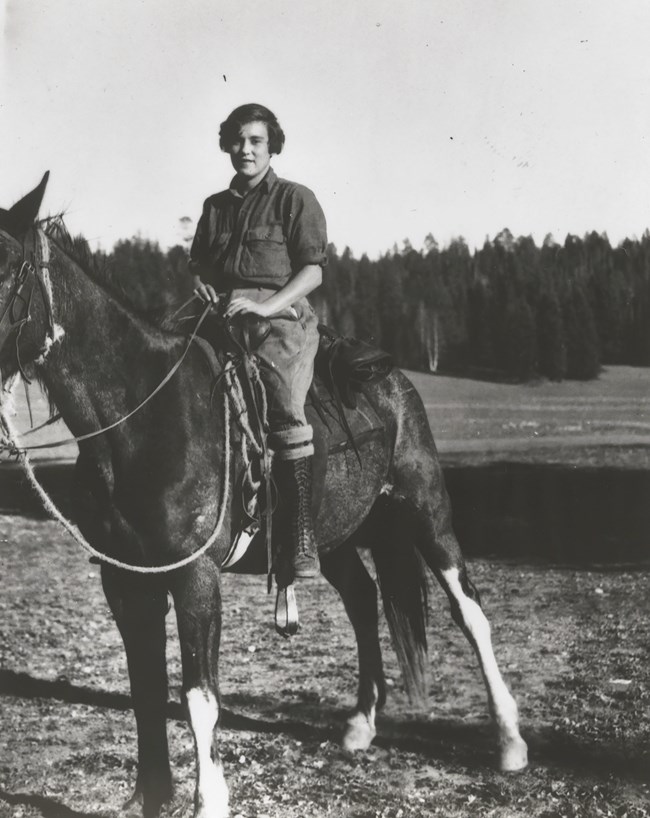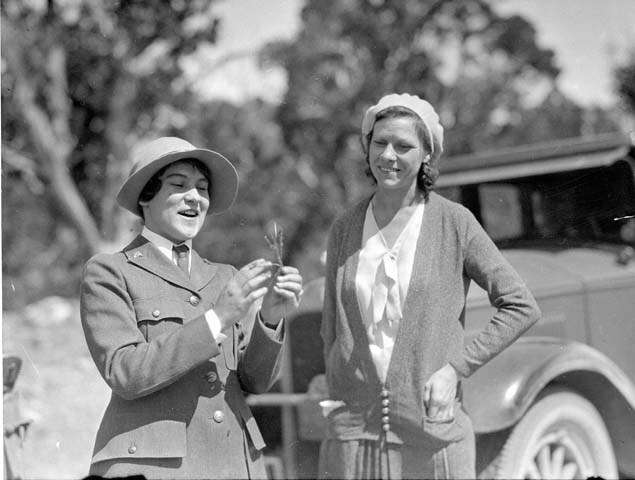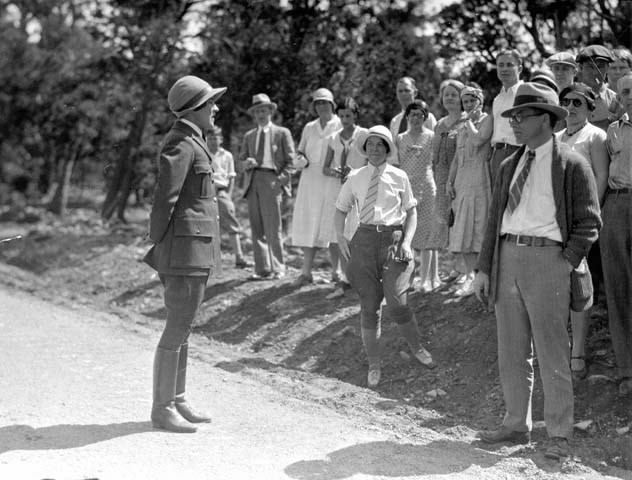Last updated: April 6, 2022
Article
Pauline Mead
Pauline “Polly” Mead was born on January 30, 1904, in Longmont, Colorado to Paul and Ariet Mead. She was the couple’s sixth child out of eight. Her parents founded the town of Mead, Colorado, in 1906. The family moved to Berthoud, Colorado, where Pauline attended a one-room schoolhouse. Around 1920 she moved to Chicago to live with her aunt and uncle while attending University of Chicago High School. As a student, she sat next to Bertha Mather (daughter of NPS Director Stephen T. Mather) in the library. She graduated from there in 1924.

Mead first visited Grand Canyon National Park in summer 1927 on a botany field trip as a University of Chicago undergraduate. The trip was as a turning point for her. In a 1978 oral history she remembered traveling to northern Utah, sharing, “We went all the way down to the north end of the Grand Canyon, and we saw these meadows out on the Kaibab Plateau and our professor, Dr. Cole, said this would be an interesting [thing] to study why the trees stop so abruptly towards the base of the meadow and then at the south end. It's such a beautiful place, and we were all carried away with the beauty of the country. I decided I'd found a study for my master's thesis. Then we went on, and I saw the Grand Canyon for the first time with this class. I walked out along the rim and it suddenly I felt as though I discovered it. It was so wonderful.” After graduating with a BS in botany in 1928, she began research for her master’s degree.
She spent summer 1928 and 1929 in the national park conducting research on the North Rim. She took overnight trips in the park to collect plant specimens, reportedly bringing just a bedroll, canteen, and plant press. She once hiked the canyon from rim to rim by herself. She recalled, “I started on the North Rim and went through the canyon to the South Rim to meet the park naturalist Edwin McKee there. I wanted to know what work had been done previously. I had blistered feet, and I was very tired, but I loved it.”
In 1928 she was invited by the Mather family to attend the dedication ceremony for the newly constructed Grand Canyon Lodge on the North Rim. She recalled returning to camp from a day of field work to find an invitation. “I dug in my trunk, got out a dress, and got myself down to the North Rim. I ate dinner with Stephen Mather, the founder and first director of the National Park Service, Hebert J. Grant, president of the Mormon Church, and Carl Grey, president of the Union Pacific Railroad. I was the only woman present.” She also recalled that Mather was interested in her research.

Later she learned that “knowing Mather didn’t hurt.” She recalled, “I read later, that [someone wrote on my application] ‘it will be remembered that Miss Mead was a guest of Stephen Mather at the dedication of the lodge.’ Women were not in favor at that time.” She was sworn in as a temporary ranger-naturalist at Grand Canyon National Park in August 1930. She was the first women ranger-naturalist at the park, earning $1,860 per year.
In her 1978 oral history, Mead recalls that she started working for the NPS in 1929 before becoming permanent in 1930. Her official personnel records don’t confirm that—there is no record of her working in 1929. It’s possible, however, that she was hired as a day laborer that year (as Yellowstone ranger-naturalist Herma Albertson was in 1926 and 1927) and therefore not recorded on official employee rolls. The records also list her position as a temporary one from August 1, 1930, until May 1, 1931.
As a ranger-naturalist Mead guided walks, delivered campfire talks, led auto caravan tours, planted wildflower gardens, collected and pressed plants for the park herbarium, and greeted visitors at the Yavapai Observation Station. She recalled, “I pretty much stuck to botany, although at one point I did lecture on geology, especially out at Yavapai. It was so wonderful to be able to lecture on the edge of the canyon and talk about the canyon, with the canyon in front of you. If I was feeling self-conscious all I had to do was look at the canyon.”
She was well received by the public but recalled an occasion where she was quite pleased with her public lecture. “When I was through I asked if there were any questions. Then, they said, ‘Sure, how old are you?’ I said I was 25.” Visitors often asked Mead how she got the job in the field.
She also remembered that a male naturalist at the time “thought that women had no business doing that type of work.” In the 1978 oral history, Mead recalls living with two or three other women, but it’s not clear what their jobs were at the park.
Mead wore the standard NPS uniform including breeches, coat, riding boots, and badge (but learn the story behind another “uniform” she wore at times in Polly’s Panache). The one difference was her hat. Instead of the ranger flat hat, the superintendent preferred she wear a style similar to that worn by women tour guides with Fred Harvey’s Indian Detours.

While working on the South Rim, Mead started dating Preston P. Patraw, the park’s assistant superintendent (and the person who swore her into her ranger-naturalist position). The two were engaged in March 1931 and married on May 1, on the day her temporary appointment ended. She recalled, “After we got married, I thought maybe I'd like to work for him, but he didn't want me to. So, I didn't, but there's always plenty to do, even if you don't get paid for it.” She made a preliminary plant list for the Grand Canyon and published articles in the park’s Nature Notes newsletter. As was common at the time, Mead was expected to stop working and stay home upon becoming a wife. Mead agreed, stating that “I just said, ‘yes, dear,’ as we did in those days.” The Patraws had a son and a daughter.
Preston Patraw’s career with the NPS took the couple from Grand Canyon to Zion and Bryce Canyon national parks in 1932; Hot Springs National Monument (now national park) in 1938; Washington, DC, in 1942; Santa Fe, New Mexico, in 1947; and finally back to Grand Canyon in 1954. When he transferred to Zion, her knowledge of Utah’s plants was considered a positive factor in his selection as superintendent. As a 1932 newspaper article noted, she was “regarded by the National Park Service as the leading authority on the flora of the southern Utah national parks and the Grand Canyon.” At Zion she worked on a plant list for the park, published articles in Zion Nature Notes, and assisted a naturalist there in his botany work—all unpaid.
In a 1941 newspaper interview from the couple’s time at Hot Springs, Pauline Patraw is quoted as saying, “Women make just as good park rangers as men and might be utilized as such during these days when men are being trained to fight” for World War II. She evidently saw limits to the role of women, however, noting, “Of course they would need some men around for policing and that sort of thing.” She seemed to still hold that opinion about 30 years later when she remarked, “If they are able, women should be superintendents but personally I like to see a man as superintendent with women at the checking jobs,” referring to women working at park entrance stations checking in cars.
She continued her botanical studies and in 1952 published Flowers of the Southwest Mesas. For decades, she gave lectures to civic organizations on the subject.
Preston Patraw retired from the NPS in 1955. The couple moved back to Santa Fe, New Mexico. They were married for more than 52 years when he died in 1984. In 1988 Polly Mead Patraw was named one of Santa Fe’s “Living Treasures.” She died on March 18, 2001, in Santa Fe.
Sources
American Southwest Virtual Museum. (n.d.). NPS Rangers and the CCC. Retrieved from https://swvirtualmuseum.nau.edu/wp/index.php/national-parks/grand-canyon-national-park/nps-rangers/
Ancestry.com. (n.d.). Social Security Applications and Claims Index, 1936-2007."City Resident is Dead at 88." (1984, January 5). The Santa Fe New Mexican, p. 2.
Davis, E., & Daly, M. (2010). Insider's Look at Grand Canyon Podcast: episode #33, Women's History Month.
Kaufman, Polly Welts. (2006). National Parks and the Women's Voice. The University of New Mexico Press.
"Grand Canyon." (1930, August 8). Williams News (Williams, Arizona), p. 6."
Patraw, Pauline Mead." (1978, September 29). Dorothy B. Huyck interview. NPS Oral History Collection. NPS History Collection, Harpers Ferry Center.
"Pauline "Polly" M. Patraw." (1988, February). Santa Fe Living Treasures--Elder Stories. Available at https://sflivingtreasures.org/index.php/treasures/2-treasures/80-patraw-polly-.html?showall=1%20%20Polly%20Patraw
"Woman, Once Park Ranger, Thinks Women Are As Capable as Men" (1941, November 12). Albuquerque Journal, p. 7.
Workman, R. B. (1998). National Park Service Uniforms: Breeches, Blouses, and Skirts 1918-1991. Harpers Ferry, WV: National Park Service History Collection.
Explore More!
To learn more about the history of women and the NPS uniform, visit Dressing the Part: A Portfolio of Women's History in the NPS.
This research was made possible in part by a grant from the National Park Foundation.
